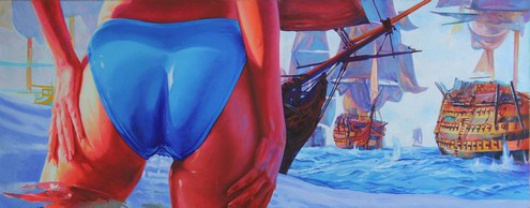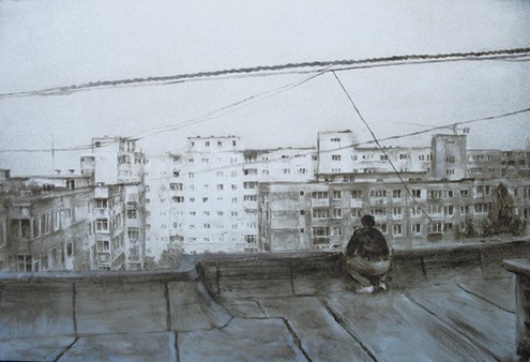Nicolae Comanescu: painting with dust in Bucharest
Published on
Translation by:
 kate hollinshead
kate hollinshead
In the truest sense of the words, the Romanian artist, 39, produces art from the dusty rubble of his home city
Traditionalists rely on oil paints, crayon, charcoals and acrylics. Nicolae Comanescu relied on these as well in his earlier series of paintings Wrong Paintings, Grand Prix Remix and Beach Culture in Bercsenyi, in which he represents the hyperactivity of the media.
 Spending your mid-life crisis on the beach (Photo: ©Nicolae Comanescu/ bercsenyi.blogspot.com)
Spending your mid-life crisis on the beach (Photo: ©Nicolae Comanescu/ bercsenyi.blogspot.com)
Now however the artist from Romania, born in 1968, paints with dust. In the attempt to capture his hometown of Bucharest using pictures, Comanescu transforms the powdery ruins of communism, the stifling material of a favoured and impressive city, into dust to produce emulations of his area which are stamped with photographic precision: deserted streets, carriages and parks not only become objects of his artistic eye but also metaphors of the dusty everyday life of everyone living in Bucharest. His exhibition ‘Dust 2.0’ is, according to the artist, not randomly just about the use of dust. It is about the matter rich in information, which reflects both subtly and strikingly the past and present of Bucharest at the same time.
What is it about your city that inspires you?
The dust in it! On first sight you should be really inspired. Bucharest is a big and complex city, rich in history and social structures of both a robust and bubbly nature. It is a city in which I have discovered that there is a lot to do and to learn.
Nicolae Comanescu: Dust 2.0
(Photos: ©dust2point0.blogspot.com)
Nevertheless there is a problem: Bucharest doesn’t inspire but exasperates its inhabitants. Anything that is favoured begins slowly to break down into dust: the historical quarter which escaped the communist impulse to destroy, the industrial architecture, parks, open spaces, markets: everything turns to dust. Nothing that has newly arisen in the city complies to a civilised plan of the city. The attempt to adapt our city to the prototype of a ‘European city’ was reneged. Forests make way for more or fewer luxurious new buildings. Communist parts of town with ugly concrete buildings become more unbearable every day. Too many cars pollute the air and fill the streets. Environmental pollution grows at an alarming pace. So it’s hard to still be inspired by anything in Bucharest. It’s not Bucharest, but its dust which has inspired me throughout this project.
Why dust as a raw material?
The dust chose me. The dust chose the city in which I live. Dust is a part of our life which we only take seriously if it crops up in large amounts. At the moment I became aware of the dust I decided to work with it. The excessive amount of it says a lot about the state of Romanian society. It’s a concentration, a matter rich in information, the worth of which is questionable. The dust in Bucharest bears different metaphors to that in New York or Barcelona, where it respectively adds to the ecological, cultural and political state of the area.
 Dust is a symbol of nostalgia, uselessness, the past, the survivors of history, a symbol of actions, of the dynamic and of evidence of our standards of living. It accompanies us at all times, from when the hooves of the Turkish messengers kicked it up until the politicians of today, who let it become hot air. Dust has often lain like a layer of mist giving the best disguise. Just as often it has blindfolded us. There are contemporary artists who speak of the dispersion of the dust through destructive communist actions. The only thing the communists ever achieved was dust from the destruction of historical monuments. Octavian Paler, a Romanian author and journalist, said ‘the dust in Romania is political.’
Dust is a symbol of nostalgia, uselessness, the past, the survivors of history, a symbol of actions, of the dynamic and of evidence of our standards of living. It accompanies us at all times, from when the hooves of the Turkish messengers kicked it up until the politicians of today, who let it become hot air. Dust has often lain like a layer of mist giving the best disguise. Just as often it has blindfolded us. There are contemporary artists who speak of the dispersion of the dust through destructive communist actions. The only thing the communists ever achieved was dust from the destruction of historical monuments. Octavian Paler, a Romanian author and journalist, said ‘the dust in Romania is political.’
(Photo: dust2point0.blogspot.com)
So do you apply a political position in your pictures?
I try not to bring myself as a political activist into my art. But it is hard to live in Romania and to close your eyes to such social injustice. Painting with dust is a conscious choice. In Romania the dust is evidence of a standard of living; it is a symbol of a corrupt political system. The political class is guilty of creating much dust in Bucharest, which at best is proof of their inability and at worst proof of ill times. As a painter I try to be a neutral observer. My intention is not to pass sentence on the Romanian government. You can see the result with the naked eye if you walk along the streets in Romania. I want to use a product of the town which bears the material and symbolic substance of Bucharest within it.
How has Bucharest developed post-Ceausescu?
Bucharest has its own dynamic. I have the impression that it nevertheless lives on and outlives regular revolutions. In the last few days of communism it was a grey, sad and starved city. Nevertheless, suspect business people and corrupt politicians awaken Bucharest into a new life once again. Even when everything still seems a little chaotic, it will sure enough settle down to normality, which pours increasingly into the blood vessels of a slowly flourishing city.
Translated from Bukarest: Staubige Reflexionen einer Stadt in Schutt und Asche


